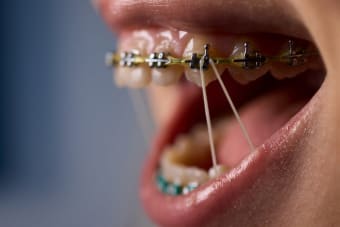
Orthodontic elastics, also known as rubber bands, are used in conjunction with braces to apply specific forces to teeth, helping correct misalignments and achieve a balanced bite. Here, orthodontists discuss the use of orthodontic elastics and where you should buy them.
Orthodontic Elastics: The Power Behind Your Braces
When you think of braces, you likely picture the brackets and wires that adorn teeth during orthodontic treatment. However, for many patients, another crucial component plays a vital role in achieving an aesthetically pleasing smile: orthodontic elastics. These small but mighty rubber bands are essential tools that orthodontists use to apply the additional force needed to move teeth into their ideal positions and correct bite issues that braces alone cannot address.
Orthodontic elastics work in tandem with traditional braces, connecting different points in the mouth to apply strategic pressure in specific directions. While they may seem like simple accessories, these tiny rubber bands are often the unsung heroes that make the difference between good and exceptional treatment outcomes.
Types of Orthodontic Elastics & Their Functions
Orthodontists classify elastics based on their purpose and how they're configured in the mouth. Each type addresses specific alignment and bite issues:
Class I Elastics
Class I elastics typically run horizontally along the same arch, either the upper or lower arch. They're commonly used to:
- Close gaps between teeth.
- Align teeth within the same jaw.
- Provide additional support during specific phases of treatment.
These elastics typically connect brackets on the same jaw, helping to fine-tune tooth positioning without affecting the bite relationship between the upper and lower teeth.
Class II Elastics
Class II elastics are designed to correct overbites, where the upper teeth protrude too far forward over the lower teeth. They run from the upper back teeth to the lower front teeth, creating a force that:
- Pulls the upper teeth backward.
- Encourages the lower jaw to move forward.
- Gradually improve the alignment of the upper and lower jaws.
Class II elastics are among the most commonly used configurations in orthodontic treatment.
Class III Elastics
Class III elastics work in the opposite direction of Class II elastics. They address underbites, where the lower teeth sit in front of the upper teeth. These elastics run from the lower back teeth to the upper front teeth to:
- Pull the lower teeth backward.
- Allow the upper jaw to move forward.
- Create proper alignment between the jaws.
Vertical Elastics
These elastics run in a more vertical direction and are used to:
- Close open bites (where the front teeth don't meet when the back teeth are together).
- Improve the interlocking of teeth for better stability.
- Enhance overall bite function.
Crossbite Elastics
These elastics help correct cross-bites, where some upper teeth sit inside the lower teeth rather than outside as they should. They're configured diagonally to apply the necessary corrective force.
How Orthodontic Elastics Work With Braces
Orthodontic elastics connect to small hooks on your braces brackets. Your orthodontist will show you exactly where and how to attach them, which typically involves stretching the elastic between specific points. When properly placed, elastics create constant, gentle tension that guides your teeth and jaws into alignment over time.
What makes elastics particularly useful is their ability to:
- Apply force in directions that braces alone cannot.
- Create the tension needed to align the relationship between your upper and lower jaws.
- Address complex bite issues that would otherwise require more invasive treatments.
- Provide customizable treatment that can be adjusted throughout your orthodontic journey.
The Importance of Patient Compliance
Orthodontic elastics only work if you wear them as directed. Unlike brackets and wires that are fixed in place, elastics rely entirely on the patient's commitment to the treatment plan. Most orthodontists instruct patients to wear their elastics 24 hours a day, removing them only for eating and oral hygiene.
The consequences of inconsistent elastic wear can include:
- Extended treatment time.
- Incomplete correction of bite issues.
- Potential setbacks in treatment progress.
- Less than optimal results.
Patient compliance with elastics is often a key factor in determining the success and duration of treatment. Your commitment to wearing your elastics as directed can mean the difference between finishing treatment on schedule or facing months of additional time in braces.
Why You Should Get Orthodontic Elastics From Your Orthodontist
A common question among patients is, 'Where can I buy orthodontic elastics?'. However, this question highlights a fundamental misunderstanding about these specialized tools. Orthodontic elastics are not items that patients should purchase from anywhere other than the orthodontist's office, and here's why:
Professional Guidance
Your orthodontist will provide you with the type of elastics required for your treatment. These elastics are:
- Selected based on your unique treatment needs.
- Sized for the correct amount of force.
- Made of medical-grade materials suitable for oral use.
- Changed frequently throughout treatment as your teeth move.
Risks of Self-Sourcing Elastics
Purchasing elastics through external sources has many potential risks, such as:
- Incorrect size or strength can damage teeth and gums.
- Non-medical grade elastics may contain harmful chemicals.
- Improper use can move teeth in unintended directions.
- Self-treatment can lead to serious and potentially irreversible dental problems.
Proper Wear & Care of Orthodontic Elastics
To get the most benefit from your orthodontic elastics, you should:
- Change them regularly (typically two to three times per day) as they lose elasticity quickly.
- Always carry spare elastics with you.
- Remove elastics when eating to prevent breakage and allow proper chewing.
- Remove elastics when brushing and flossing to enable thorough cleaning.
- Wash your hands before handling new elastics to maintain hygiene.
- Follow your orthodontist's specific instructions about wear patterns and timing.
Your orthodontist will provide you with enough elastics to last between each appointment. If you do run out, you should contact your orthodontist's office to request more.
